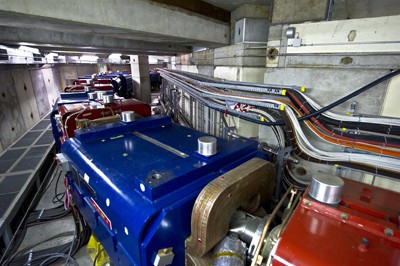
CERN’s 27-km Large Hadron Collider (LHC) is gradually restarting after being shut down for 16 months following a major maintenance and upgrade programme. CERN scientists hope that the upgrade – costing SwFr 150m (€124m) – will now boost the energy of the collider to the full design energy of 13 TeV.
The LHC is at one end of a chain of proton accelerators that support a large number of diverse experiments. Some of these experiments have also undergone significant upgrades. Others are new and have goals ranging from finding physics beyond the Standard Model to developing electronic components that are resistant to radiation damage.
The LHC has been out of action since February 2013 when it was turned off following a successful three-year run operating at 7 TeV. Although the collider was not running at its full design energy of 13 TeV, this was enough in July 2012 to enable scientists to announce the detection of the elusive Higgs boson particle, which had first been theorized in 1964 and led to François Englert and Peter Higgs sharing the 2013 Nobel Prize for Physics.
Methodical restart
Having upgraded the LHC, which involved consolidating 10,000 superconducting magnet interconnections, CERN is now methodically restarting the accelerator chain step by step and conducting tests before the planned resumption of full operations next year. The first stage in a proton’s journey to the LHC is the Proton Synchrotron (PS), which was fired up in mid-June. Several experiments that use protons from the PS are already taking data, including AIDA, which is a test bed for new particle-detector technologies. The long-running ISOLDE radioactive ion-beam facility on the PS is expected to resume operations by the end of July. Meanwhile, two new irradiation facilities – IRRAD and the CHARM – are nearing completion and should be ready in September.
Protons from the PS are also fired into a block of metal to create high-energy antiprotons, which are then slowed by the Antiproton Decelerator (AD). The AD is now in the process of being powered up and should be fully operational by 19 August. The AD supplies antiprotons to five experiments. Stefan Ulmer who works on two of them – BASE and ASACUSA – told physicsworld.com that the commissioning process at the AD is proceeding as planned. BASE is a new experiment that aims to measure the magnetic moment of the antiproton and should start gathering data in early September.
Extremely precise measurements
Early last month, CERN also began to power up the Super Proton Synchrotron (SPS), which accelerates protons from the PS and feeds them to the LHC. The physics programme at the SPS will begin again in October and will include the new NA62 experiment. NA62 is looking for new physics beyond the Standard Model of particle physics by trying to make an extremely precise measurement of the probability that a positively charged kaon will decay to a positively charged pion plus a neutrino/antineutrino pair.
From early 2015 the beam will be back at the LHC, and in spring 2015 the physics programme will restart at the LHC’s four experiments.
“The machine is coming out of a long sleep after undergoing an important surgical operation,” says Frédérick Bordry, CERN’s director for accelerators and technology. CERN’s main objective for next year is to run the LHC at 13 TeV – a level that it is hoped will enable deeper studies of the Higgs boson and the hunt for supersymmetric particles.
There is much more about CERN’s NA62 experiment in this video:



